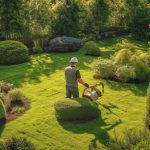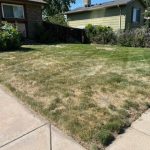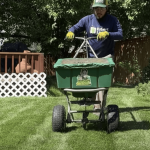Have you seen Japanese Beetles flying around? Maybe on your roses, bushes or trees? Well if you have them their larvae might be in your lawn waiting to hatch into a grub. If this is the case you will want to read on to learn more about the life cycle of lawn grubs, the damage they can cause to a lawn and how to prevent that damage.
Lawn Grub Cycle:
Grubs:
This is the larval stage of the infamous Japanese beetles.
There are four stages in the cycle:
-Egg
-Larva
-Pupa
-Adult.
Understanding the life cycle will help you understand how to manage the grubs.
Egg Stage:
In spring or early summer, Japanese beetles will lay eggs in the soil. Within a few weeks the eggs will hatch and white, fat, C-shaped grubs will be living in your soil under the turf.
Larva Stage:
This is the most known cycle of the grub’s life because this is when you may be able to see damage in the lawn. Brown areas may start appearing because the grubs are eating at the roots and decaying organic matter in the soil. They are most active during the warmer months of the season.
Pupa Stage:
As the growing season comes to an end, the grubs burrow deeper into the soil to transform into pupae. Pupation is a stage of metamorphosis during which the grub undergoes significant changes to develop into an adult beetle.
Adult Stage:
This occurs once the transformation is completed. You will begin seeing beetles emerging from the soil. Once they have emerged from the soil they will then go on a search for a mate. The cycle starts again because they will lay eggs to start a new generation.
Lawn Grub Damage:
Grubs can be a silent killer in your lawn. Since they live in the soil under the turf, you may not know you have them until you begin to notice changes in your lawn. You will start to see brown patches or areas of dead grass. If this is caused by grubs you can usually identify it because the areas that are brown will easily lift up. This occurs because the grubs feed on the roots of the grass, making the grass easy to lift. Once you lift the grass, typically, you will see the little white, worm-like grubs right in the soil. You will typically see this type of damage during late summer and early fall because this is when the grubs are most active and feeding on the roots.
If you haven’t noticed the brown areas right away, wild life might be another indicator of grubs. Animals such as skunks, raccoons and birds will feed on grubs. You might see these creatures digging in specific areas of your lawn and causing more damage. They are doing this to get access to the grubs to feed on them.
Effective Control Strategies:
There are several ways to try to mitigate the effects of the grubs in your lawn. Of course, most people want to find the most environmentally friendly way of doing this to keep the balance of your ecosystem.
Cultural Practices:
To start you will want to make sure you have a strong and healthy lawn and can be less susceptible to grubs. You can do this by maintaining the lawn on a regular basis, ensuring that the lawn is mowed at an ideal height and with consistent watering. By doing this you will be encouraging deeper root growth, which will help the overall strength of your lawn.
Biological Control:
If you wanted to introduce Nematodes (microscopic worms) into your lawn, they would act as a natural predator to the grubs. You can purchase these and introduce them into the soil to start combating the grubs living in the soil.
Milky Spore:
Milky spore disease is caused by a bacterium that specifically targets Japanese beetle grubs. Applying milky spore powder to your lawn can establish a long-term control method, as the bacterium multiplies and persists in the soil.
Chemical Treatments:
If you have tried these methods and you are not seeing success you can resort to applying an insecticide to the lawn. You want to be careful when applying any products to ensure you are not causing further damage. If you need help with a grub control or a grub preventative service, Erbert Lawns can help with this.
Fall Lawn Renovation:
If you are seeing activity in the lawn, late summer or early fall is the best time to try to eradicate the grubs. During this time you will see that they come closer to the surface, which makes treatment for them better. If you were not able to fully prevent them and you see some damage in the lawn, you can consider a liquid aeration with overseed to help repair the damage the grubs caused.
Conclusion:
By understanding the life cycle of grubs, you can hopefully prevent some of the damage they are known to cause in a lawn. During the warmer months you want to be more aware of your lawn and any changes that are occurring. If you are seeing browning areas and there’s no explanations, pull the grass up and if you don’t see roots, you can most likely assume there are grubs nearby. The great thing though, there are methods to protect your lawn and eliminate these nasty pests.

Kelsey Keller
Business Manager
With six years of experience in lawn care, Kelsey Keller has learned the
many facets of what it takes to make lawn green and weed free. She pays close attention to
what customers need and what will make their lawn happy. She continues to learn and discover
what the turfs in Colorado need to be able to thrive.










